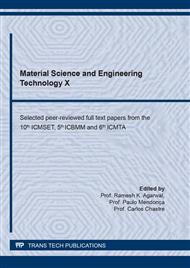[1]
A. A. McNevin, in: Aquatic Animal Health and the Environmental Impacts, edited by G. Jeney, in Fish Diseases, chapter, 10, Academic Press (2017).
Google Scholar
[2]
G. Ramanjaneyulu and B. R. Reddy, in: Emerging Trends of Microorganism in the Production of Alternative Energy, edited by V. Buddolla, in Applied Microbiology and Biochemistry, chapter, 21, Academic Press (2019).
DOI: 10.1016/b978-0-12-816328-3.00021-0
Google Scholar
[3]
A. Khanunthong et al: Thailand Industry Outlook 2021-2023. Krungsri Research. (2021), p.1–6.
Google Scholar
[4]
D. N. Thoai, C. Tongurai, K. Prasertsit, and A. Kumar: Review on Biodiesel Production by Two- Step Catalytic Conversion. Biocatalysis and Agricultural Biotechnology Vol. 18 (2019), p.101023.
DOI: 10.1016/j.bcab.2019.101023
Google Scholar
[5]
A. Hayyan et al: Reduction of high content of free fatty acid in sludge palm oil via Acid Catalyst for biodiesel production. Fuel Processing Technology Vol. 92 (2011), p.920–924.
DOI: 10.1016/j.fuproc.2010.12.011
Google Scholar
[6]
R. Pruszko, in: Biodiesel Production, edited by A. Dahiya, in Bioenergy (Second Edition), chapter, 23, Academic Press (2020).
Google Scholar
[7]
I. Chanakaewsomboon, K. Phoungthong, A. Palamanit, V. Seechamnanturakit, and C. K. Cheng: Biodiesel Produced Using Potassium Methoxide Homogeneous Alkaline Catalyst: Effects of Various Factors on Soap Formation. Biomass Conversion and Biorefinery (2021).
DOI: 10.1007/s13399-021-01787-1
Google Scholar
[8]
I. Chanakaewsomboon, C. Tongurai, S. Photaworn, S. Kungsanant, and R. Nikhom: Investigation of Saponification Mechanisms in Biodiesel Production: Microscopic Visualization of the Effects of FFA, Water and the Amount of Alkaline Catalyst. Journal of Environmental Chemical Engineering Vol. 8 (2020), p.103538.
DOI: 10.1016/j.jece.2019.103538
Google Scholar
[9]
J. M. Marchetti, V. U. Miguel, and A. F. Errazu: Possible Methods for Biodiesel Production. Renewable and Sustainable Energy Reviews Vol. 11 (2007), p.1300–1311.
DOI: 10.1016/j.rser.2005.08.006
Google Scholar
[10]
J. Y. Park, D. K. Kim, and J. S. Lee: Esterification of Free Fatty Acids Using Water-Tolerable Amberlyst as a Heterogeneous Catalyst. Bioresource Technology Vol. 101 (2010), p.62–65.
DOI: 10.1016/j.biortech.2009.03.035
Google Scholar
[11]
M. Kouzu, T. Kasuno, M. Tajika, Y. Sugimoto, S. Yamanaka, and J. Hidaka: Calcium Oxide as a Solid Base Catalyst for Transesterification of Soybean Oil and Its Application to Biodiesel Production. Fuel Vol. 87 (2008), p.2798–2806.
DOI: 10.1016/j.fuel.2007.10.019
Google Scholar
[12]
N. Diamantopoulos, D. Panagiotaras, and D. Nikolopoulos: Comprehensive Review on the Biodiesel Production Using Solid Acid Heterogeneous Catalysts. Thermodynamics and Catalysis Vol. 6 (2015), p.1–8.
DOI: 10.4172/2157-7544.1000143
Google Scholar
[13]
T. Dong, J. Wang, C. Miao, Y. Zheng, and S. Chen: Two-step in Situ Biodiesel Production from Microalgae with High Free Fatty Acid Content. Bioresource Technology Vol. 136 (2013), p.8–15.
DOI: 10.1016/j.biortech.2013.02.105
Google Scholar
[14]
N. Boz, N. Degirmenbasi, and D. M. Kalyon: Esterification and Transesterification of Waste Cooking Oil Over Amberlyst 15 and Modified Amberlyst 15 Catalysts: Applied Catalysis B: Environmental Vol. 165 (2015) p.723–730.
DOI: 10.1016/j.apcatb.2014.10.079
Google Scholar
[15]
G. Fan, C. Liao, T. Fang, S. Luo, and G. Song: Amberlyst 15 as a New and Reusable Catalyst for the Conversion of Cellulose into Cellulose Acetate. Carbohydrate Polymers Vol. 112 (2014), p.203–209.
DOI: 10.1016/j.carbpol.2014.05.082
Google Scholar


